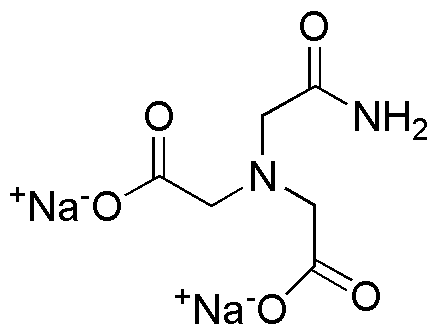N-(2-Acetamido)-2-iminodiacetic acid disodium salt is widely utilized in research focused on:
- Biochemical Research: This compound serves as a chelating agent, effectively binding metal ions in biological systems, which is crucial for studying enzyme activities and metal ion interactions.
- Pharmaceutical Formulations: It is used in drug formulations to enhance solubility and stability, making it beneficial in developing medications that require precise metal ion control.
- Analytical Chemistry: The compound is employed in various analytical techniques, such as chromatography and spectrophotometry, to improve the accuracy of metal ion detection in samples.
- Environmental Studies: It aids in the remediation of heavy metal contamination in water and soil, providing a practical solution for environmental cleanup efforts.
- Food Industry: As a food additive, it helps in controlling metal ion levels, ensuring food safety and quality, particularly in processed foods.
General Information
Properties
Safety and Regulations
Applications
N-(2-Acetamido)-2-iminodiacetic acid disodium salt is widely utilized in research focused on:
- Biochemical Research: This compound serves as a chelating agent, effectively binding metal ions in biological systems, which is crucial for studying enzyme activities and metal ion interactions.
- Pharmaceutical Formulations: It is used in drug formulations to enhance solubility and stability, making it beneficial in developing medications that require precise metal ion control.
- Analytical Chemistry: The compound is employed in various analytical techniques, such as chromatography and spectrophotometry, to improve the accuracy of metal ion detection in samples.
- Environmental Studies: It aids in the remediation of heavy metal contamination in water and soil, providing a practical solution for environmental cleanup efforts.
- Food Industry: As a food additive, it helps in controlling metal ion levels, ensuring food safety and quality, particularly in processed foods.
Documents
Safety Data Sheets (SDS)
The SDS provides comprehensive safety information on handling, storage, and disposal of the product.
Product Specification (PS)
The PS provides a comprehensive breakdown of the product’s properties, including chemical composition, physical state, purity, and storage requirements. It also details acceptable quality ranges and the product's intended applications.
Certificates of Analysis (COA)
Search for Certificates of Analysis (COA) by entering the products Lot Number. Lot and Batch Numbers can be found on a product’s label following the words ‘Lot’ or ‘Batch’.
*Catalog Number
*Lot Number
Certificates Of Origin (COO)
This COO confirms the country where the product was manufactured, and also details the materials and components used in it and whether it is derived from natural, synthetic, or other specific sources. This certificate may be required for customs, trade, and regulatory compliance.
*Catalog Number
*Lot Number
Safety Data Sheets (SDS)
The SDS provides comprehensive safety information on handling, storage, and disposal of the product.
DownloadProduct Specification (PS)
The PS provides a comprehensive breakdown of the product’s properties, including chemical composition, physical state, purity, and storage requirements. It also details acceptable quality ranges and the product's intended applications.
DownloadCertificates of Analysis (COA)
Search for Certificates of Analysis (COA) by entering the products Lot Number. Lot and Batch Numbers can be found on a product’s label following the words ‘Lot’ or ‘Batch’.
*Catalog Number
*Lot Number
Certificates Of Origin (COO)
This COO confirms the country where the product was manufactured, and also details the materials and components used in it and whether it is derived from natural, synthetic, or other specific sources. This certificate may be required for customs, trade, and regulatory compliance.


